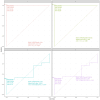Synucleins As Biomarkers of Severity in Autism Spectrum Disorder
- PMID: 39398840
- PMCID: PMC11471306
- DOI: 10.7759/cureus.69356
Synucleins As Biomarkers of Severity in Autism Spectrum Disorder
Abstract
Introduction Autism spectrum disorder (ASD) is a lifelong disorder affecting children quite early in life, manifested as delays in communication and stereotypic behaviors. To date, it is diagnosed clinically using the Diagnostic and Statistical Manual-5 (DSM-V) criteria due to the lack of biomarkers that can specifically denote the disorder. The role of synucleins in this context has been considered due to the increasing evidence of neurodegeneration in many autistic children. Synucleins are a group of soluble neuronal proteins primarily expressed in the central nervous system. They are of three types: α-, β-, and ɣ-synuclein. α-synuclein is involved in vesicle trafficking and release of neurotransmitters. There is no uniformity in the scientific community regarding their levels of autism, with few studies showing increasing levels and others to the contrary. Hence, the present study was conceived to analyze the levels of α-synuclein and β-synuclein in autistic children and to correlate with the disease severity. Objectives The main objective of the study was to assess the levels of α- and β-synuclein in autistic children of 2-8 years of age and to identify the correlation between the severity of core symptoms of autism and α- and β-synuclein levels. It is intended to assess the possibility of using α- and β-synuclein/their ratio as a biomarker of the severity of autism. Materials and methods Plasma levels of α-synuclein and β-synuclein were measured in 160 ASD children and 40 healthy age and sex-matched children by ELISA. Their symptom severity was assessed with CARS-2 ST and the Indian Scale of Autism Assessment (ISAA). Values of α- and β-synuclein were analyzed for correlation with the severity rating of ASD. Cut-off values of α-synuclein and β-synuclein that discriminate the presence of autism and its severity were assessed using Jamovi 2.4.14 software. Results The results show that α-synuclein levels were significantly reduced (5.02 ± 0.586; range: 3.13-6.0 ng/ml) when compared with healthy controls (29.47 ± 18.62 ng/ml; range: 22.39- 36.56) with p < 0.001, and β-synuclein levels were elevated (1424 ng/ml ± 122; range: 1229-1616 ng/ml) when compared to control, though not significantly. Plasma levels of α-synuclein significantly correlate with disease severity with good diagnostic accuracy (86%), but β-synuclein levels did not correlate with severity. The fold changes of synucleins, especially the fold decrease in levels of α-synuclein, were discriminative for the diagnosis and severity with good sensitivity (93.6%), specificity (74.3%), positive predictive (92.6%), and negative predictive values (76.5%). The fold increase in β-synuclein did not have any significance in predicting the severity of autism. Conclusion The present study showed that α-synuclein and β-synuclein were associated with ASD and can be used to assess its severity. A fold decrease in α-synuclein was found to have good discriminating value in differentiating the severity of autism. It may be of use especially in mild and high-functioning autism, when clinically distinguishing them may be difficult.
Keywords: alpha-synuclein; autism biomarker; autism spectrum disorder (asd); beta-synuclein; childhood autism rate scale; circulating biomarker; serum biomarker.
Copyright © 2024, D. V. Nair et al.
Conflict of interest statement
Human subjects: Consent was obtained or waived by all participants in this study. Institutional Ethics Committee of Saveetha Medical College and Hospital issued approval 003/06/2021/IEC/SMCH. Animal subjects: All authors have confirmed that this study did not involve animal subjects or tissue. Conflicts of interest: In compliance with the ICMJE uniform disclosure form, all authors declare the following: Payment/services info: All authors have declared that no financial support was received from any organization for the submitted work. Financial relationships: All authors have declared that they have no financial relationships at present or within the previous three years with any organizations that might have an interest in the submitted work. Other relationships: All authors have declared that there are no other relationships or activities that could appear to have influenced the submitted work.
Figures



Similar articles
-
Plasma Levels of Alpha and Gamma Synucleins in Autism Spectrum Disorder: An Indicator of Severity.Med Princ Pract. 2021;30(2):160-167. doi: 10.1159/000513935. Epub 2020 Dec 21. Med Princ Pract. 2021. PMID: 33348337 Free PMC article.
-
Significant Changes in Plasma Alpha-Synuclein and Beta-Synuclein Levels in Male Children with Autism Spectrum Disorder.Biomed Res Int. 2018 Apr 8;2018:4503871. doi: 10.1155/2018/4503871. eCollection 2018. Biomed Res Int. 2018. PMID: 29850516 Free PMC article.
-
Diagnostic tests for autism spectrum disorder (ASD) in preschool children.Cochrane Database Syst Rev. 2018 Jul 24;7(7):CD009044. doi: 10.1002/14651858.CD009044.pub2. Cochrane Database Syst Rev. 2018. PMID: 30075057 Free PMC article. Review.
-
Association of urinary polycyclic aromatic hydrocarbon metabolites with symptoms among autistic children: A case-control study in Tianjin, China.Autism Res. 2022 Oct;15(10):1941-1960. doi: 10.1002/aur.2788. Epub 2022 Aug 8. Autism Res. 2022. PMID: 36218012
-
[ADI-R and ADOS and the differential diagnosis of autism spectrum disorders: Interests, limits and openings].Encephale. 2019 Nov;45(5):441-448. doi: 10.1016/j.encep.2019.07.002. Epub 2019 Sep 5. Encephale. 2019. PMID: 31495549 Review. French.
References
-
- Improvement of behavioural pattern and alpha-synuclein levels in autism spectrum disorder after consumption of a beta-glucan food supplement in a randomised, parallel-group pilot clinical study. Raghavan K, Dedeepiya VD, Ikewaki N, Sonoda T, Iwasaki M, Preethy S, Abraham SJ. BMJ Neurol Open. 2022;4:0. - PMC - PubMed
-
- The role of α-synuclein in neurotransmission and synaptic plasticity. Cheng F, Vivacqua G, Yu S. J Chem Neuroanat. 2011;42:242–248. - PubMed
LinkOut - more resources
Full Text Sources
Research Materials
